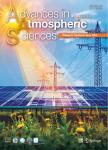Latitudinal and Scan-dependent Biases of Microwave Humidity Sounder Measurements and Their Dependences on Cloud Ice Water Path
Latitudinal and Scan-dependent Biases of Microwave Humidity Sounder Measurements and Their Dependences on Cloud Ice Water Path作者机构:Joint Center of Data Assimilation for Research and Applications Nanjing University of Information Science and Technology Earth System Science Interdisciplinary Center University of Maryland College Park
出 版 物:《Advances in Atmospheric Sciences》 (大气科学进展(英文版))
年 卷 期:2019年第36卷第5期
页 面:557-569页
核心收录:
学科分类:07[理学] 0706[理学-大气科学] 0816[工学-测绘科学与技术] 0825[工学-航空宇航科学与技术] 0702[理学-物理学]
基 金:supported by the National Key R&D Program of China (Grant No. 2018YFC1507302) the Mathematical Theories and Methods of Data Assimilation supported by National Natural Science Foundation of China (Grant No. 91730304)
主 题:bias microwave humidity sounder ice water path Community Radiative Transfer Model
摘 要:The relationship between differences in microwave humidity sounder(MHS)–channel biases which represent measured brightness temperatures and model-simulated brightness temperatures, and cloud ice water path(IWP) as well as the influence of the cloud liquid water path(LWP) on the relationship is examined. Seven years(2011–17) of NOAA-18 MHS-derived measured brightness temperatures and IWP/LWP data generated by the NOAA Comprehensive Large Array-data Stewardship System Microwave Surface and Precipitation Products System are used. The Community Radiative Transfer Model, version2.2.4, is used to simulate model-simulated brightness temperatures using European Center for Medium-Range Weather Forecasts reanalysis data as background fields. Scan-angle deviations of the MHS window channel biases range from-1.7 K to1.0 K. The relationships between channels 2, 4, and 5 biases and scan angle are symmetrical about the nadir. The latitudedependent deviations of MHS window channel biases are positive and range from 0–7 K. For MHS non-window channels,the latitudinal deviations between measured brightness temperatures and model-simulated brightness temperatures are larger when the detection height is higher. No systematic warm or cold deviations are found in the global spatial distribution of difference between measured brightness temperatures and model-simulated brightness temperatures over oceans after removing scan-angle and latitudinal deviations. The corrected biases of five different MHS channels decrease differently with respect to the increase in IWP. This decrease is stronger when LWP values are higher.



